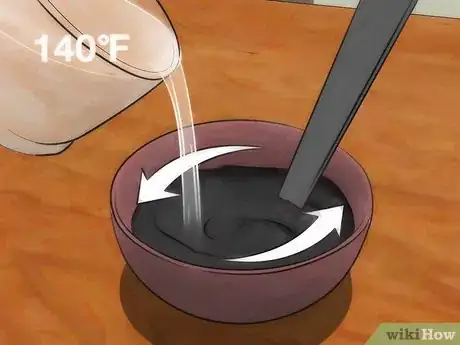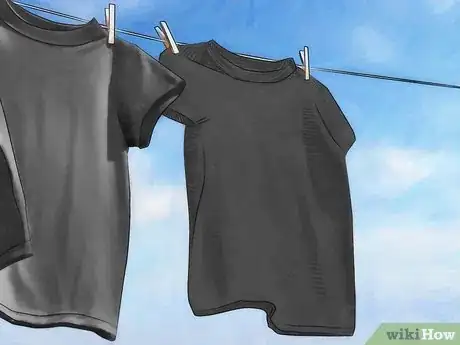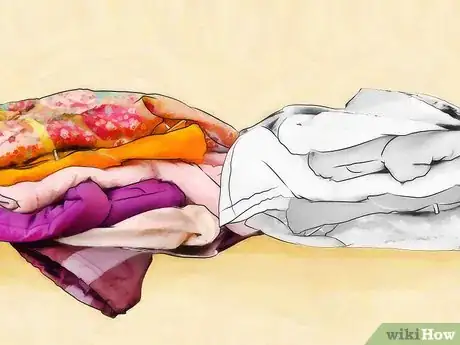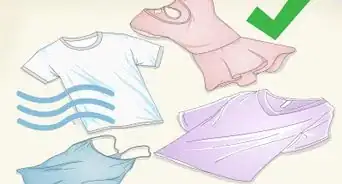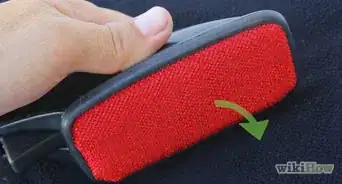This article was co-authored by Kamel Almani and by wikiHow staff writer, Amber Crain. Kamel Almani is a Laundry and Cleaning Specialist and the Co-Owner of WashyWash, a toxin-free and eco-friendly laundry and dry clean service based in Amman, Jordan. Kamel and his staff at WashyWash use Blue Angel certified and dermatologically-tested detergents. They also combine EcoClean and digital technology to provide an eco-friendly, convenient, and quality cleaning service. Kamel holds a BA in Design from the University of Applied Science, Amman.
wikiHow marks an article as reader-approved once it receives enough positive feedback. This article received 14 testimonials and 100% of readers who voted found it helpful, earning it our reader-approved status.
This article has been viewed 436,002 times.
Almost all black clothing eventually begins to fade after repeated washing and drying, leaving you with a closet full of dull grey shirts and pants. Instead of going out and buying new clothing to replace your faded items, try out one of the techniques for restoring the color of your garments at home.
Steps
Restoring With Dye
-
1Determine if your fabric will receive dye. Fabric dye works best on natural fabrics such as cotton, linen and silk. Synthetics such as rayon and nylon are also good candidates. There are a couple of fabrics that won’t accept dye well – 100% polyester and spandex. Avoid attempting to dye those.
- It’s recommended that you don’t attempt to dye the fabric of any garment labelled “dry clean only”.
- The different fabrics absorb dye differently from one another, with results that vary in appearance. If you are concerned about a particular garment, test a swatch first.
-
2Prepare your workspace. Cover your entire workspace with plastic or newspaper before you begin. Make sure to have sponges and paper towels within reach in case of spillage. Use plastic buckets, stainless steel buckets or a stainless steel sink to create your dye bath.
- Don’t use bath tubs made of porcelain or fiberglass for any part of the dyeing process because they will stain.
- You will need to be wearing rubber gloves during the entire dyeing and rinsing process.
Advertisement -
3Fill your bucket or stainless steel sink with very hot water.[1] The hotter the water, the deeper the color result.[2] 140°F/60°C is the maximum temperature you can use and will result in the deepest black color. Make sure you use enough hot water to completely submerge your garment.
- If you want the deepest black and your tap water doesn’t get hot enough, use a stove, tea kettle or microwave to heat the water.
-
4Pre-dissolve your powder dye in a separate container in very hot water. Be sure to dissolve it thoroughly and use a chopstick or any other handy tool you don’t mind staining to stir the mixture until well mixed. If you’re using liquid dye, all you need to do is shake it well before adding it to the bucket.
- Check the dye packaging to make sure you are using enough dye for the amount of clothing you’re dying. The amount needed varies from product to product, so consult the packaging or insert for exact measurements.
-
5Pour the mixture into your dye bath (the bucket/sink). Make sure that the mixture blends well into the hot water. There needs to be enough water in the bucket so that your garment can move around freely and be stirred while in the dye bath. This is so that your garment will get evenly dyed.
- Add one tablespoon of laundry detergent to the dye bath. This will help promote dye absorption. Make sure that you stir the laundry detergent into the dye bath until it is well dissolved.
- When dyeing cotton, rayon, ramie, or linen, add 1 cup of table salt to the dye bath. This will intensify the color.
- When dyeing nylon, silk and wool, add 1 cup of white vinegar to the dye bath to intensify the color.
-
6Submerge your garment in the dye bath.[3] The longer your garment is left in the dye bath, the darker the result will be. Garments can be left in the bath for up to 1 hour.[4] You will need to constantly agitate and stir the garment while it’s submerged in the bath.
- Try to keep the temperature of the water as consistently hot as possible.[5] Have a stove top, microwave or tea kettle nearby to heat water up to use to refresh the dye bath.
- Another option would be to use a large stainless steel pot for the dye bath and go through the process with the pot being heated on the stove to keep a consistent temperature.
- If you soak your clothing in plain hot water for a few minutes before putting them in the dye bath, it will smooth them out so that they can accept dye even more easily.
-
7Remove the clothing from the dye bath and rinse it in warm water first. Warm water removes the dye on the surface of the garment more efficiently. After the warm rinse, then rinse in cold water. Keep rinsing until the water runs clear.
-
8Hang or machine dry the clothing. You can dry your items either way, but hang drying clothing preserves their dark colors, so it’s probably a better idea to get in that habit. Once dry, your clothing is ready to wear.
- For the first 3 times you wash your newly dyed clothing after wearing, wash the items alone in cold water using the gentle cycle and mild, non-bleach detergent.
- After that you can wash the dyed items with other items of the same color that haven’t been dyed, but make sure it’s always in cold water and using a mild detergent.
Restoring With Coffee
-
1Put your garments in the washing machine. If you are darkening multiple items, make sure they are all similar in color. Start your normal wash cycle using cold water.
- This method is most effective when used on cotton fabrics, like faded black t-shirts. The effects aren't as ideal on other types of fabrics.
- If you want to restore clothing to a very rich black color, coffee is less effective than black fabric dye. Coffee will have more natural-looking results.
-
2Brew up a pot of very strong black coffee. The stronger the coffee, the darker the final outcome will be, so keep that in mind when brewing. You will need 2 cups of coffee for this so use a full sized coffee maker, not a single serve or smaller coffee maker.
- You can also use 2 cups of black tea instead of the coffee for similar results, if that's your preference.
- It doesn't matter how you get the two cups of coffee, as long as they are fresh and dark. If you're an instant coffee drinker, it's perfectly fine to make your coffee with that. Being brewed by a coffee maker isn't a requirement.
-
3Add 2 cups of the freshly brewed coffee to the washing machine when the rinse cycle begins.[8] Close the lid of your washing machine and let the machine and coffee do their work. Allow the rest of the cycle to finish up just as it normally would.
- If you've used commercial fabric dyes on your clothing before, you'll notice that this method smells much better during the process and after.
- The coffee method is also non-toxic, and you don't have to worry about coffee staining the basin of your washing machine.
-
4Hang your clothing to dry. Machine drying dark garments can lead to fading, so get in the habit of always hanging up your black clothes after washing them to preserve their color. Once dry, the garment is ready to wear.
Preventing Color Loss
-
1Wash dark clothing only when necessary. Each wash cycle contributes to additional fading, so the less you wash them, the better.[9] This is especially true of denim, which fades the most easily.
- To get away with washing your dark clothes infrequently, take them off and let them air out after wearing them instead of washing. Put the item on a hanger and hang it somewhere by itself for a day before putting it back in the closet.
- After wearing the item and air drying 2 or 3 times, go ahead and wash it.
-
2Sort your clothes by color and weight before washing them. Always wash your dark colors together, otherwise the colors may bleed and stain any lighter colored items being washed. Also sort your clothing by fabric type and weight.
- If you wash delicate items with garments made of heavier fabric, the delicates can get damaged and the heavier fabrics probably won’t get as clean as they should.[10]
-
3Hand wash your delicate items and fragile fabrics. The agitation caused by your washing machine during a cycle is far too harsh for your delicates. Hand wash these items in cold water to preserve their color and to prevent the items from being damaged.
- If you really want to avoid hand washing your laundry, the next best thing is to get a small mesh bag for your delicates. Put them in the mesh bag prior to putting them in the washing machine. This will cut down on damage to your delicates.
- If you have any garments that you are unsure how to launder, dry clean them.
-
4Turn your black clothes inside out before washing them.[11] This protects your black clothing by guarding it against the agitation caused by your washing machine. The wash cycle distresses the fibers of black clothing, which causes them to break down and then fade.
-
5Wash your clothes in cold water using the gentle cycle. Warm and hot water can lead to fading and using any other cycle besides gentle when washing dark colors can also lead to fading. These cycles are much rougher on your clothing and the gentle cycle will protect and preserve garments.
- If your washing machine also has a soil setting, always use the light-soil setting (unless your clothes are really dirty). The light-soil setting is far gentler on dark color than the other settings.[12]
-
6Use a detergent made specifically for black or brightly colored clothing. Never use regular laundry detergent with bleach or bleach alternatives. Several companies make detergents that are specifically for use with dark colored clothing, so use that if you can find it.
- Use the minimum amount of detergent necessary to get your garments clean. Excess detergent can lead to fading.
-
7Hang your clothes to dry. Don’t machine dry your black clothes any more, since the dryer can contribute to additional fading. Pull the items from the machine, shake them out and immediately hang the items individually on a rack so that they can dry.
- Once completely dry, they are ready to be stored in your closet with the rest of your wardrobe.
Community Q&A
-
QuestionWill black dye change the color of white stripes on black clothing?
 wikiHow Staff EditorThis answer was written by one of our trained team of researchers who validated it for accuracy and comprehensiveness.
wikiHow Staff EditorThis answer was written by one of our trained team of researchers who validated it for accuracy and comprehensiveness.
Staff Answer wikiHow Staff EditorStaff AnswerYes, this can happen either during washing or deliberate dyeing of the garment. First, if the black dye runs from the black clothing during washing, it will change the white stripes to a dull gray or even a black color. Second, if you are using the black dye method suggested in the steps above, then the white stripes will definitely be dyed black, so you shouldn’t use any dyeing method on clothes with other colors than black on them or you’ll dye those areas too.
wikiHow Staff EditorStaff AnswerYes, this can happen either during washing or deliberate dyeing of the garment. First, if the black dye runs from the black clothing during washing, it will change the white stripes to a dull gray or even a black color. Second, if you are using the black dye method suggested in the steps above, then the white stripes will definitely be dyed black, so you shouldn’t use any dyeing method on clothes with other colors than black on them or you’ll dye those areas too. -
QuestionHow do you keep black clothes from fading in vinegar?
 wikiHow Staff EditorThis answer was written by one of our trained team of researchers who validated it for accuracy and comprehensiveness.
wikiHow Staff EditorThis answer was written by one of our trained team of researchers who validated it for accuracy and comprehensiveness.
Staff Answer wikiHow Staff EditorStaff AnswerVinegar usually helps to prevent fading rather than cause it and it can brighten blacks by removing soap residue that has built up on the clothing over several washes. Overuse of vinegar might be too harsh on some fabrics though, so just don’t use it too often on your black clothes, and that should ensure it doesn’t contribute to any fading or weakening of the fibers.
wikiHow Staff EditorStaff AnswerVinegar usually helps to prevent fading rather than cause it and it can brighten blacks by removing soap residue that has built up on the clothing over several washes. Overuse of vinegar might be too harsh on some fabrics though, so just don’t use it too often on your black clothes, and that should ensure it doesn’t contribute to any fading or weakening of the fibers. -
QuestionHow can I fade my black clothes?
 wikiHow Staff EditorThis answer was written by one of our trained team of researchers who validated it for accuracy and comprehensiveness.
wikiHow Staff EditorThis answer was written by one of our trained team of researchers who validated it for accuracy and comprehensiveness.
Staff Answer wikiHow Staff EditorStaff AnswerTo fade your black clothes, do the opposite to the things you’d need to do to prevent them from fading! For example, to help them fade, try washing the black clothes in hot water, and use a strong detergent. Also, dry them on high in the dryer and leave them the right side out when washing. Repeat these things until the clothes have faded enough for your needs.
wikiHow Staff EditorStaff AnswerTo fade your black clothes, do the opposite to the things you’d need to do to prevent them from fading! For example, to help them fade, try washing the black clothes in hot water, and use a strong detergent. Also, dry them on high in the dryer and leave them the right side out when washing. Repeat these things until the clothes have faded enough for your needs.
References
- ↑ http://www.primermagazine.com/2014/spend/back-from-the-dead-revive-your-faded-favorite-jeans-by-dyeing-them-for-less-than-5
- ↑ Rani Gorgis. Laundry & Cleaning Specialist. Expert Interview. 7 April 2021.
- ↑ Kamel Almani. Laundry & Cleaning Specialist. Expert Interview. 13 April 2021.
- ↑ Rani Gorgis. Laundry & Cleaning Specialist. Expert Interview. 7 April 2021.
- ↑ Rani Gorgis. Laundry & Cleaning Specialist. Expert Interview. 7 April 2021.
- ↑ http://www.primermagazine.com/2014/spend/back-from-the-dead-revive-your-faded-favorite-jeans-by-dyeing-them-for-less-than-5
- ↑ Kamel Almani. Laundry & Cleaning Specialist. Expert Interview. 13 April 2021.
- ↑ http://bottomlineinc.com/household-magic/how-to-get-black-clothes-blacker/
- ↑ Rani Gorgis. Laundry & Cleaning Specialist. Expert Interview. 7 April 2021.
- ↑ http://www.consumerreports.org/laundry-cleaning/how-to-keep-your-black-clothes-looking-their-best/
- ↑ Kamel Almani. Laundry & Cleaning Specialist. Expert Interview. 13 April 2021.
- ↑ http://www.consumerreports.org/laundry-cleaning/how-to-keep-your-black-clothes-looking-their-best/
About This Article
To brighten faded black clothes, first put them in the washer on a normal cycle using cold water. Then brew 2 cups of very strong black coffee or tea. When your washer’s rinse cycle starts, add the coffee or tea, then let the cycle finish. Hang the clothes to dry, since putting them in the dryer can fade them. You can also try using fabric dye to brighten dark colors. Just be aware that works best on natural fibers, like cotton and silk. For more information on brightening your faded black clothes, including using a dye bath, read on!




